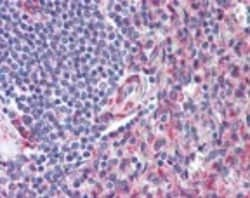Promotional price valid on web orders only. Your contract pricing may differ. Interested in signing up for a dedicated account number?
Learn More
Learn More
Invitrogen™ CD97 Polyclonal Antibody


Rabbit Polyclonal Antibody
Supplier: Invitrogen™ PA141590
Description
PA1-41590 detects Leukocyte Antigen CD97 in chimpanzee, mouse and human samples.
CD97 is a G-protein-coupled seven-span transmembrane adhesive receptor that is constitutively expressed on granulocytes and monocytes and rapidly upregulated on T and B cells upon activation. CD97 is produced in alternatively spliced forms and its cellular ligand is CD55 (DAF), which protects various cell types from complement-mediated damage. Interaction of CD97 on leukocytes and CD55 on vessel cells probably facilitate leukocyte activation and migration into the tissues, similarly, CD97 seems to play a role in tumour migration and invasiveness. CD97 is involved in T cell regulation and peripheral granulocyte homeostasis.
Specifications
| CD97 | |
| Polyclonal | |
| Unconjugated | |
| ADGRE5 | |
| AA409984; Adgre5; adhesion G protein-coupled receptor E5; Cd97; CD97 antigen; CD97 antigen subunit alpha; CD97 antigen subunit beta; CD97 molecule; EGF-TM7 receptor; leukocyte antigen CD97; seven transmembrane helix receptor; seven-span transmembrane protein; seven-transmembrane, heterodimeric receptor associated with inflammation; TM7LN1 | |
| Rabbit | |
| Antigen affinity chromatography | |
| RUO | |
| 26364, 976 | |
| Store at 4°C short term. For long term storage, store at -20°C, avoiding freeze/thaw cycles. | |
| Liquid |
| Immunohistochemistry (Paraffin), Western Blot | |
| 0.5 mg/mL | |
| PBS with 0.2% gelatin and 0.05% sodium azide | |
| P48960, Q9Z0M6 | |
| ADGRE5, CD97 | |
| A portion of amino acids 220-270 of human Leukocyte Antigen CD97. | |
| 100 μg | |
| Primary | |
| Human, Mouse, Monkey | |
| Antibody | |
| IgG |
Product Content Correction
Your input is important to us. Please complete this form to provide feedback related to the content on this product.
Product Title
Spot an opportunity for improvement?Share a Content Correction


